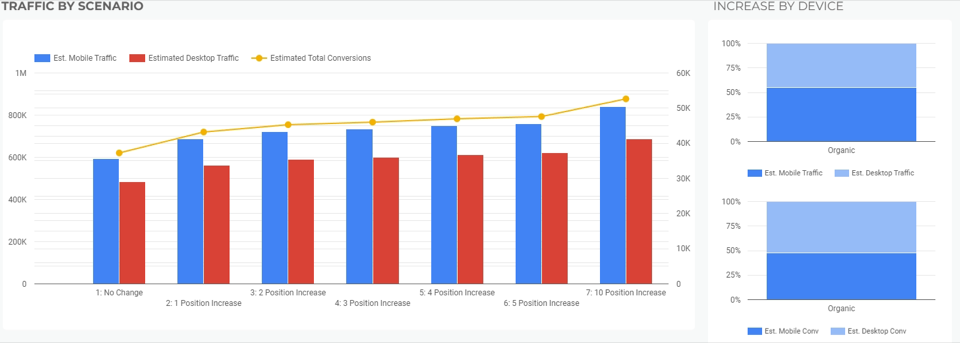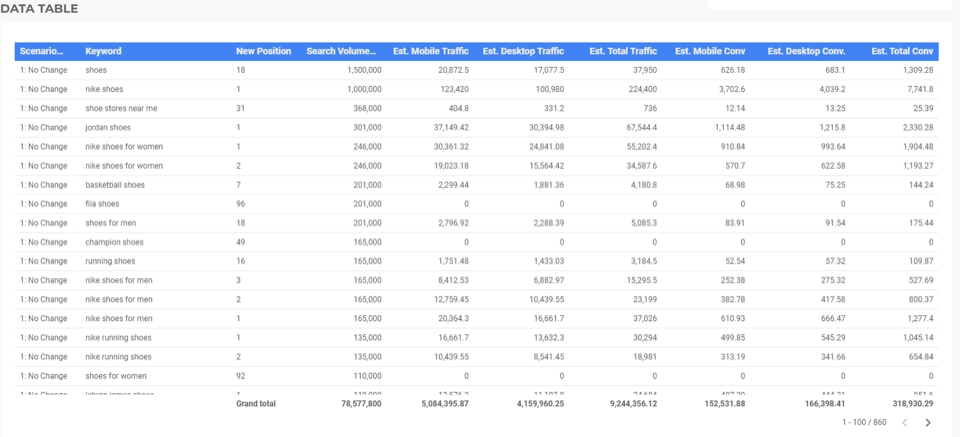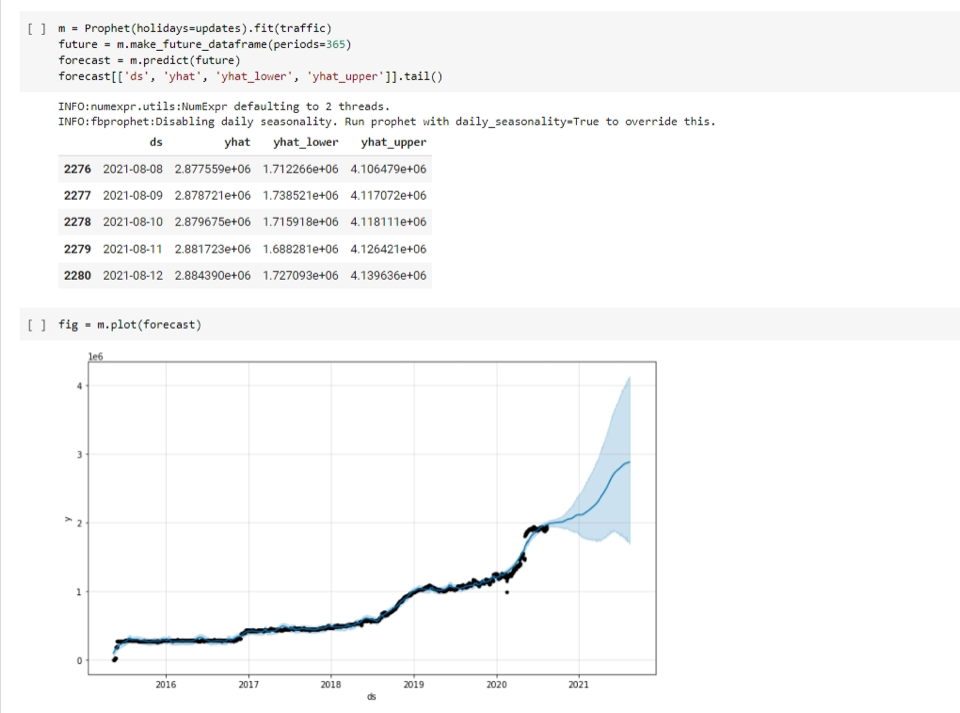To newcomers, knowing what your potential customers are thinking and what strategies will work best in the future can seem like a challenging and ambiguous task. Search engine optimization (SEO), can be a far more precise marketing tool than clients realize. SEO forecasting lets agencies and clients figure out what sort of performance businesses can expect from using certain keywords and SEO strategies in the future.
How It Works
SEO forecasting works by using data sets from a variety of sources such as Google and your own website’s analytics to predict future traffic. Some metrics that businesses look at while forecasting include: current and past website traffic, changes in the number of searches, click-through-rate, and keyword ranking. As complicated as that might sound, agencies can perform robust and quick analyses using scripts.
Why SEO Forecasting Matters
Big data, the field that SEO forecasting draws from, will be a 68B USD industry by 2025. This indicates the future of tech and opportunities for businesses of all sizes. SEO forecasting has massive implications for both businesses gauging their performance and agencies working in digital marketing.
- Businesses: Whether you’re starting in marketing or leading the team, you’ve got targets to meet both for the current year and the next. SEO forecasting helps businesses estimate their future performance and fine-tune their operations to meet their targets, making sure their marketing strategies are always aligned with their long-term goals.
A popular use of forecasting is to analyze how competitors in your industry are doing relative to you. A forecast visually places their organization’s future trajectory relative to yours, making it easier to chart a strategy for the future. For example, if their business is forecasted to outgrow yours in the future, you will know it’s time for a change in your strategy. - Agencies: SEO forecasting helps agencies understand what works for clients and what doesn’t. When onboarding new clients or even conducting reviews with existing ones, agencies can forecast the kind of growth clients can expect in the future. Showing skill in forecasting also demonstrates domain expertise to your clients, letting them know you understand SEO trends well.
For example, if forecasting reveals that your client isn’t performing up to par, you can use that information to figure out a way to boost your SEO performance and perhaps even make a compelling case for more funds.
An additional use-case that sometimes goes overlooked is the fact that SEO forecasting can be used to optimize for existing keywords, not just new ones. If you’re reluctant to re-optimize multiple pages of content for new, riskier keywords, you can just improve interlinking and existing keyword usage in title and meta tags, and see if that brings you an increase in traffic by forecasting.
That said, it’s good to remember that due to factors like a lack of consistent information on how search engines work, seasonal factors, and algorithm updates, predictions from SEO forecasting can’t be taken as set in stone and are subject to change.
How to Create an SEO Forecast
Phase 1: Gathering Data
Getting a thorough understanding of your website and industry is the first step to creating a good forecast. Have a look at your website’s past SEO performance, look out for the peaks as well as the low points along with seasonal information such as page views on certain holidays.
If you’ve been operational for a long time, it’ll be easier to collect a larger amount of data. The more you can gather, the more accurate the forecast will be.
Phase 2: Analyze and Execute
Once you’ve gathered your data, you will have to work out what all that information means. A good place to start here is to account for the peaks and the troughs in your data. Some questions you can ask include:
- If there was a peak, did it coincide with any holidays?
- Did you shift to a different platform before a peak/trough?
- Were there any changes in your marketing strategy at the time of an anomaly in the data that could explain it?
Essentially, you’ll be looking at your historical SEO performance through the lens of consumer behavior, global events, and the search engine algorithm.
Using Tools
For smaller teams that might not have the time to compile and parse through large amounts of data, tools can automate the process. Automating the initial data collection and preparing a template makes it easy for customization later.
Before we look at some popular SEO forecasting tools, it’s important to point out that automating will not do the whole job for you. Effective SEO forecasting needs a keen eye for business analytics to turn data into performance.

Google Data Studio
Google Data Studio offers an easy (and free!) way to process raw data into comprehensive and eye-catching forecasts. It works by allowing users to draw from over 800 data sets from popular connectors like AdRoll and Adobe Analytics. Users can turn this data into parsed information in the form of tables and graphs, as per their needs.
As a free tool, Google Data Studio is perfect for beginners experimenting with forecasting that might not have an advanced understanding of coding and the intricacies of SEO and are looking to get some quick insights into their performance.
The downside of Google Data Studio is that there are much better alternatives for marketers who are experienced in SEO tools and want greater customizability when processing their data.


Semrush
Semrush is great for people who have a moderate-advanced understanding of SEO content optimization tools like content gap analysis and topic clusters. As a forecasting tool, it lets you take a detailed look at your competitors’ activities, including their backlinks and how their keywords are doing relative to yours.
As a tool that integrates competitive analysis, Semrush is a natural complement for businesses performing an SEO forecast. Admittedly, the amount of data available can be overwhelming for people who don’t have a lot of experience with digital marketing tools.
Prophet
Just like Google Data Studio, Prophet is a free analytic tool by Facebook, and the similarities end there. Prophet requires at least a working knowledge of Python or R to be an effective tool for SEO forecasting. There are three things that make Prophet stand out from competitors.
- Open Source: Open-source functionality means that people who are familiar with programming languages can customize and adapt Prophet to suit their organization’s SEO performance monitoring needs.
- Speed and Accuracy: Prophet is reliable for a variety of applications not limited to SEO forecasting, which is why it’s used extensively in-house at Facebook. Part of the reason it’s so fast is that it is completely automated, so issues like messy or missing data get accounted for, without any extra work on your part.
- Time Analysis: Prophet’s most popular attraction for data scientists is the fact that it analyzes data on a weekly, monthly and annual basis while also looking at holiday trends.
If you’ve got someone on the team who’s proficient with Python or R, Prophet is a handy way to estimate how your SEO strategy will perform in the future.

Ahrefs
Ahrefs forecasting tool is one of the most widely used in the industry. Ahrefs specializes in organically creating graphs using both third and first party (Google Analytics, etc.) data. The benefit of using third-party data is that it allows for a birds-eye view of how your competitors’ sites are performing relative to yours. The plug-and-play scripts they provide are perfect for marketers looking for a brief analysis.
Ahrefs forecasting tool might not hit the mark completely for marketers who need either highly accurate data to create a content strategy around or a flexible forecasting tool that can incorporate other metrics. Surprisingly, 63% of businesses aren’t taking advantage of a content strategy.
Making The Most of The Results
Raw and processed data in analytics reports is of no use if marketers can’t decipher it and put it into action. Before making any changes in your strategy based on future SEO performance trends or even before you begin forecasting, you should ask yourself a few important questions.
- What is the end goal of your digital marketing strategy? Have you set quantifiable targets?
- Do you have the budget to implement changes in SEO strategy? (i.e re-doing old articles and pushing for new ones)
- Which keywords can you optimize for?
Optimizing Pages
A simple use-case universal for both agencies and businesses is ROI-forecasting. Let’s take an up and coming business with limited resources as an example. If the business uses blogs to generate backlinks and convert interested readers, it can calculate whether changing certain keywords will result in an increase in SEO performance.
The business could plug in the cost of writing that article, the average likelihood that it’ll convert to a sale, and the potential readership to determine if the ROI is high enough to consider publishing the article. It is also important to optimize content to increase page rank and ROI as 90% of traffic lands on page one.
Depending on how frequently businesses conduct forecasts, either monthly, quarterly, or on an ad-hoc basis, they can be used as indicators for resource allocation within the organization. The variety of metrics that can be predicted, such as lead generation and traffic, can help businesses create effective marketing strategies.
Seasonality
Part of using forecasting intelligently is the art of prudence, that is to say, knowing when not to act. Let’s say a forecast predicts a surge in page visits if you change an important keyword that’s been performing relatively well for you. A beginner might get lured by the promise of higher SEO performance in exchange for optimizing the page for this new keyword, without realizing that keyword popularity can be seasonal.
A projection showing favorable results in favor of a new keyword is not a guarantee of consistency, as it might fall in popularity the year after that. Seasoned marketers should look for long-term trends and know when to dig-in with their existing strategy, as re-optimizing multiple pages without looking at the bigger picture can be incredibly costly for the business.
Demonstrating SEO Value
The bottom line is that while SEO forecasting is a useful tool to gauge future performance, it shouldn’t be the only metric you base long-term decisions on. Here are some useful ways to measure SEO value for clients and your own business that can complement your forecasts:
- Comparison with paid options: A good way to know if it’s worth switching to a promising set of keywords that look promising on a forecast is to compare the value you’d get by implementing them organically as opposed to getting visits through paid traffic.
- Widen your metrics: Incorporating other metrics that incorporate different data sets such as click-through-rate or ‘time spent on page’ can give marketers a more wholesome idea of SEO performance.
Forecasting For Success
SEO forecasting is a convenient way for businesses to stay on their feet and always be on the lookout for new trends, evolving a little more every day. Join the BESTSEO blog to learn about new ways to optimize your website for success.

